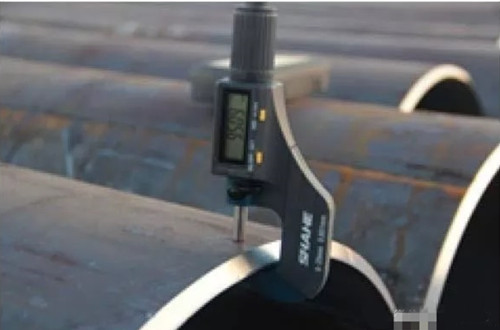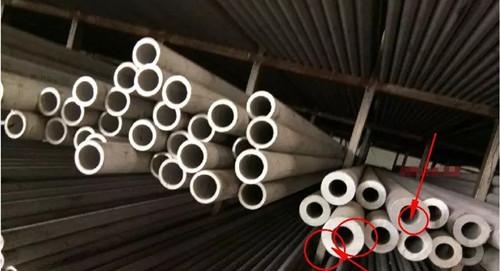The finished product of seamless precision steel pipe will have the problem of uneven thickness. How did it happen? Many people do not understand. Today we will talk about how the uneven thickness of seamless steel pipes such as cold drawn steel pipes, cold-rolled steel pipes and hot rolled steel pipes is caused. Why is the thickness of seamless steel pipes not so ideal?

Measuring the thickness of the steel pipe

If you look closely, you can still see a little bit of uneven thickness of steel pipes
Uneven thickness of steel pipes easily occurs in the manufacturing process of hot-rolled steel pipes. Uneven thickness probably appears in the hot piercing. According to the anatomical analysis of the steel pipe after it is drilled by an automatic tube rolling mill, we believe that after the pierced solid tube pierces the steel pipe through the automatic rolling mill, the uneven wall thickness of the steel pipe in the vertical and horizontal directions basically retains the distribution characteristics of the uneven wall thickness of perforating solid tube. That means the steel pipe still has spiral uneven wall thickness after piercing, and the horizontal uneven wall thickness is significant. The reasons for the uneven wall thickness due to the automatic rolling mill are as the following:
(1) The existence and severity of uneven wall thickness of perforating solid tube directly affect the existence and severity of uneven wall thickness of steel pipes after rolling.
(2) When the pipe is rolled on the automatic pipe rolling mill, the position of the head is deviated from the center of the hole due to the bending of the head of perforating solid tube, resulting in uneven wall thickness. The positions of the maximum wall thickness and minimum wall thickness on each cross section of the middle and head of the pipe are almost fixed, while the uneven wall thickness from the end of the tube to the tube head gradually increases. Therefore, reducing the residual curvature of the head of perforating solid tube and the axial force of the head of perforating solid tube during tube rolling has a significant effect on decreasing uneven wall thickness effect.
(3) The greater the amount of wall reduction is, the more serious the uneven wall thickness of the round bar steel becomes. When the amount of wall reduction is small, the automatic rolling mill has the effect of reducing the uneven wall thickness of the perforating solid tube.
(4) The hole is not adjusted correctly. When the roll gap is not parallel, the uneven wall thickness of the steel pipe will increase.
Our seamless steel pipe plant has performed Fourier transform on the measured wall thickness data of the four rolling process such as the Φ400mm automatic tube rolling mill, piercing, secondary piercing (extension), automatic tube rolling and leveling, and obtained quantitative analysis and reasons for the uneven wall thickness. Methods of improving the uneven wall thickness of steel pipes are as the following based on the quantitative analysis and reasons:
(1) After the secondary perforation or extension, the uneven distribution of the spiral wall thickness on the steel pipe remains until the finished pipe. Therefore, improving the secondary perforation or extension is the key link to improve the wall thickness accuracy of the finished pipe. The main measure is improvement of the tool design, which is to improve the concentricity of the rod and head of the perforating solid tube with the rolling line during the rotation process.
(2) Improving the uneven wall thickness of the steel pipe after perforation is an important link. The main measures are to improve the heating uniformity of the steel pipe, to improve the accuracy of the centering hole, to lengthen the length of the entire belt and the length of the reverse cone and to improve the concentricity of the rod and head of the perforating solid tube with the rolling line during the rotation process.
(3) Although serious symmetrical uneven wall thickness occurs during tube rolling, it has a certain effect on reducing the spiral wall thickness. Therefore, the steel pipe should be rolled twice when it is rolled, and the steel pipe should be turned 90° each time.
(4) The leveling process can basically eliminate symmetrical uneven wall thickness, but it has little effect on eliminating spiral uneven wall thickness. Therefore, the capacity of the entire machine should be improved.
(5) Fourier transform is an effective method to study the uneven wall thickness of the cross-rolling process. This method can also be used to study the uneven wall thickness of other steel pipe production units.



